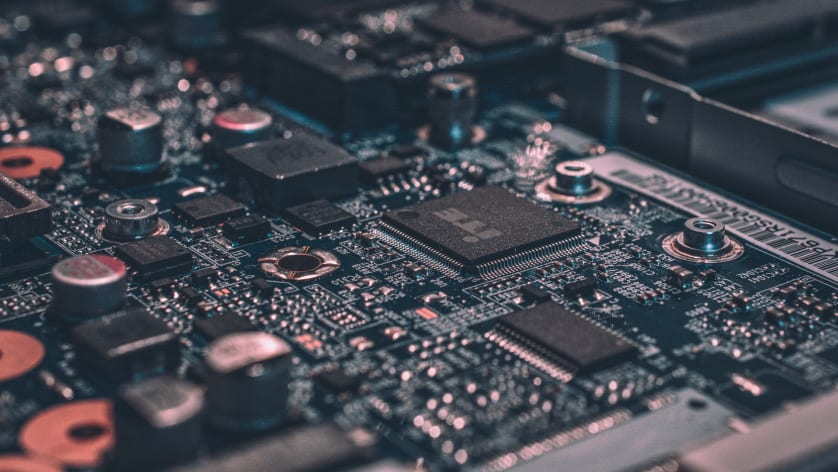What is Computer Hardware?

Hardware is created by building circuits with electronic components and can be located either within the computer or as an external device connecting to the computer’s ports. All hardware components must be functioning properly and transmitting signals correctly for the computer to operate without error, and most hardware can be replaced or upgraded to create a more powerful machine. Popular hardware upgrades to increase a computer's total accessible memory include installing RAM or replacing a monitor with a higher definition screen.
Computer hardware can be classified as either internal or external.
Internal hardware:
- CPU
- Mainboard
- Drives (CD, SSD, HDD, Blue-ray)
- Power supply
- Graphics card (GPU)
- RAM
- Fans
- Sound card
- Case
- Network card
- CPU Cooler (Fan or water cooled)
External Hardware:
- Monitor
- Mouse
- Keyboard
- Webcam
- Speaker
- Headset
- Projector
- USB drive
- Printer
- Microphone
Semiconductor: What is that?
The semiconductor is a key element in many of the technologies we rely on daily, from cell phones and televisions to refrigerators and LED light bulbs.
Silicon is the most commonly used semiconductor and is key to the creation of electronic components and the namesake for “Silicon Valley.”
TOP SEMICONDUCTOR INDUSTRY COMPANIES
- Samsung
- AMD
- Intel
- SK Hynix
- Taiwan Semiconductor Manufacturing (TSMC)
- Micron Technology
- Qualcomm
- Broadcom
- Texas Instruments
SUPERCOMPUTERS & QUANTUM COMPUTING
Supercomputer:
A supercomputer is a type of computer that is much more powerful than a regular computer. Many processors are contained within modern supercomputers, and these computers can perform billions of calculations each second, otherwise known as FLOPS, or floating-point operations per second. Supercomputers today are largely composed of multiple computers that work in parallel in order to increase performance and accomplish various tasks simultaneously.
Supercomputers are powerful tools that can be used for real-time applications, data-intensive processes, and heavy computations.
High-performance computing has enabled enterprises to shirk the traditional model of maintaining an on-premises supercomputer in favor of scalable remote servers capable of producing massive processing power.
Hardware for supercomputers:
Supercomputers are composed of hundreds of thousands of individual components, most of which are designed to support the internal processes that enable the supercomputer to produce massive amounts of computational power.
Supercomputer hardware includes:
- Processors: Supercomputers have the capacity for tens of thousands of processors to perform billions of computations in a single second.
- Memory: Supercomputers have high volumes of memory, which allows for quick access to information. A group of processors that create a node is packaged with a block of memory in a supercomputer.
- Interconnect: The interconnect between nodes allows for simultaneous tasking and collective problem solving, as well as connections to I/O devices.
- I/O System: The input/output system includes disk drives, networking and tape drives, all of which support the peripheral subsystem.
- Power supply: Because they require so much power, supercomputers' power supplies are always being updated and upgraded.
Quantum computing explained
Quantum computing is a novel and advanced form of computing that has the potential to scale exponentially, making significant advancements in fields such as materials science, pharmaceuticals, machine learning, and disease diagnosis possible. Quantum computers use quantum mechanics to produce qubits, rather than classical computing's binary 0 and 1 states.
Qubits are subatomic particles that can exist in more than one state simultaneously. This allows qubits to be processed at a much faster rate than traditional binary bits.
- Superposition: Qubits can represent more than one combination of 1 and 0 at a time, whereas binary can only exist in one of two states. Superposition is the ability of a quantum system to exist in two or more states simultaneously. By being in multiple states at the same time, a quantum computer can analyze a large number of potential outcomes simultaneously. When the final result of a calculation is measured, the qubit collapses to either a 1 or a 0.
- Entanglement: Entanglement is what creates exponential increases in processing power whenever an extra qubit is added. Quantum computers use multiple linked entangled qubits to speed up calculations through the use of unique quantum algorithms.
Quantum computer hardware:
Using qubits for an extended period of time requires extremely cold temperatures - any heat introduced into the system can introduce critical errors, known as decoherence. Quantum computers must be able to create and operate at temperatures close to absolute zero.
The dilution refrigerator is a cooling system used by quantum computers to maintain their temperatures; this system mixes the properties of two helium isotopes to allow qubits to exist inside.
- The qubit signal amplifier is the first stage of amplification in a quantum computer, which is cooled to a temperature of 4 kelvin.
- By inputting microwave lines, we can attenuate each stage in the refrigerator to protect qubits from detrimental thermal noise while sending control and readout signals to the processor.
- Superconducting coaxial lines are used to direct signals between the first two amplification stages and are made out of superconductors to minimize energy loss.
- Cryogenic isolators help reduce noise and improve qubit quality.
- Quantum amplifiers are used to capture and amplify processor readout signals while keeping noise to a minimum.
- By protecting the quantum processor from electromagnetic radiation, the cryoperm shield helps to maintain its quality.
- The mixing chamber is situated at the lowest part of the chamber and provides the immense cooling power necessary to reduce the processor and other components down to an extreme temperature of 15mK.













